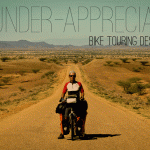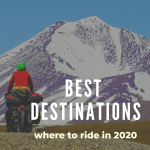The question you’ve been dying to ask.
Almost nobody ever comes right out and asks us how we finance our round the world bicycle tour.
But most people are curious as to how we were able to quit our jobs and became full-time cycle nomads for over a decade.
Here’s how we finance our round the world bicycle tour. I’ve broken it down into four easy steps.
#1 The essential first step: we maximized our incomes
As we all know, the more money being injected into our bank accounts each month, the more potential for savings. Sometimes there’s a trade-off between a dream job that you find fulfilling and a high salary job that will allow you to top up your savings.
In our case, optimizing our income potential meant living outside our home countries and working for ourselves.
Had Eric stayed in France, slowly working his way up the career ladder, it is doubtful we would enjoy the financial freedom we have today.
Better opportunities abroad
As much as Eric loves France, he saw better career opportunities abroad.
Giving up an entry-level post close to home, he hopped across the border to Germany. There he nabbed a job at an international organization and doubled his salary overnight. Eventually, he went freelance, another smart economic move.
Freelance was also the direction I eventually went, training business people on how to communicate in English and teaching language courses at the local university.
Risks and rewards
While freelancing came with certain risks (no guaranteed monthly paycheck or sick pay) and extra responsibilities (we had to arrange our own health insurance and retirement plans) the rewards of freelancing (higher salaries and more flexibility) far outweighed the drawbacks.
Of course, you don’t need to move abroad and strike out as a freelancer to finance a bicycle tour around the world.
What you may need to do is reconsider your current employment situation and decide whether it allows you to meet your financial goals. This may mean accepting a job that is less personally fulfilling but pays better. It may mean taking a second job evening or weekends. Or it may mean going abroad. Many cycle tourists that we meet worked in London before touring. They lived in a shared flat and saved as much as possible so they could set off on tour.
#2 We lived below our means
If you continue to live like a student after you have a well paying professional job, you can save a lot of money. FAST. That’s what we did.
All our furniture was either second-hand or free stuff we picked up off the street. Our clothing was mostly picked up at flea markets and thrift shops. We rode our bicycles almost everywhere. Eventually, we bought a cheap second-hand car because it was cheaper to drive back to France to visit the in-laws than take the train.
Restaurants were strictly for special occasions such as birthdays and our anniversary. We took vacations, but always as backpackers, sleeping in cheap hostels and eating street food.
Our colleagues were buying fancy SUVs and taking cruises and ski vacations.
There’s lots of info out there on how to live simply and save for the future. Most of us, I’m convinced, can find ways to cut back on spending without enjoying life any less.
Our strategy for financial freedom
For us, the key was to focus on our travel dreams.
After a year backpacking through South America, we returned to Germany in 2003 with one goal: financial freedom.
We set ourselves a goal and committed to it.
Then we set about saving—never losing sight of the adventures that lay ahead.
An extra job walking a neighbor’s dog meant one more night in a hotel each time I leashed up Fido. A Saturday night spent at home watching movies rather than dining out translated into an extra 3 days on the road. Moving into a comfortable 600 Euro ($850) a month apartment rather than a spacious 3-bedroom house with a garden meant an extra $1000 a month stashed away into the travel fund.
Money that could have gone into furniture (all giveaways), new clothes (ours were invariably second hand), transportation (we rode our bikes to work), restaurants (we cooked at home, mostly with ingredients purchased at discount supermarkets) and fancy vacations (we always backpacked) went into saving for our future.
During this three year period of focused economizing, we were able to put aside a fair amount of cash for the future. And we enjoyed life. Living simply in no way diminished our overall level of happiness.
#3 We found a way to generate monthly income
If you’ve got a decent job and are the owner of a brand-new Prius or a $40,000 SUV, nobody asks you how you can possibly afford such a luxury.
Nobody questions how you managed to buy a 4-bedroom house with a big yard in the suburbs.
And if you fork over $3,000 (+ airfare) for a packaged week-long holiday in Bali nobody bats an eye.
That’s why I continue to be shocked at the reaction I get when I tell people that Eric and I are the owners of three small apartments.
People start looking at us like we’re some kind of wealthy land barons or evil property owners. In fact, we just made different spending decisions.
What works for us
While many people choose to “sell everything” and set off on a round-the-world bicycle tour, we didn’t want to go that route.
Being in our mid-40’s, we’re well aware that retirement age isn’t far off in the future. We’ve planned for that, realizing that our future employment prospects may not be as bright as they once were.
We figured a steady stream of income would be the best way to go about sustainable travel. For us, that steady flow of cash into our bank account is rental income.
And that rental income is what now keeps us afloat as we cycle around the world. It’s not much. After taxes and expenses, we’re left with around $600 a month. Not a lot of money. But just enough money for us to cycle around the world without depleting our retirement savings.
#4 We found ways to minimize our expenses on the road
Everybody seems to want to know how much it costs to cycle around the world. That’s a little like asking how much it costs to rent a flat in London, go out to dinner in Paris or buy a head of cattle in Montana.
It all depends on what you want.
Just check out Travelling Two’s new series on what cycle touring costs and you’ll get a feel for the wide range of responses.
Those disinclined to camping, cooking and “roughing it” could find themselves shelling out $1,000-$2,000 a month per person for a no-holds-barred comfort tour.
Minimalists (think Biciclown) can get by on less than $10 a day (possibly $5) no matter if they’re touring in Japan or Jamaica.
While our style of touring definitely falls on the budget end of the spectrum, we’re hardly masochists on a Tour de Souffrance.
Smart ways to save
Let’s face it, cyclists really have only two things on which to spend money: food and accommodation.
If you’re out to cut costs, food–the touring cyclist’s fuel source–is clearly off limits. Sure, you can stick to street stalls and self-catering and forego all the treats that make life worth living, but it still won’t make much of a dent in your overall expenses.
It’s far more effective, we’ve found, to tackle the cost of accommodation.
In the beginning
When our tour began back in 2006, we paid for a place to sleep almost every single night. Some pretty awful places in fact. $15 for a crappy campsite on some jam-packed Spanish beach, $10 for a filthy hotel room next to a brothel in Burkina Faso, a whopping $50 for dorm beds in a Belgian hostel.
In retrospect, an absolute waste of money. Around $3,500 down the drain in the first twelve months of bicycle travel just for accommodation.
Do you know how much we spent on lodging during the previous 12 months of travel? $600
Not much. And that includes bike touring through relatively pricey places like Chile, Argentina, Taiwan, Malaysia and Canada.
Over the years, we’ve cut our accommodation costs to almost nothing. Here’s how we keep our travel costs so low.
Perfecting the art of free camping
Once you start seriously searching for free places to pitch your tent, you’ll find that it’s really not that tricky.
Just in the past month, we’ve pitched our tent at Buddhist temples, mosques, police stations, and in the yard of random individuals. We’ve also been invited in to enjoy the night at a beach resort and in a comfortable air-conditioned room at the Highway Patrol in Thailand.
While free camping may feel awkward at first, I assure you it’s loads of fun (most of the time). Check out this article for ideas on where to look for a safe place to sleep for free and this article for more tips on free camping.
We got active in Hospitality Networks
Finding some random place to pitch your tent is perfect when you’re just passing through, but hardly practical when you want to hang around for a few days and visit a place.
Whenever I meet fellow cyclists, I ask if they are familiar with the free hospitality networks Couchsurfing and Warm Showers.
While most of our fellow bicycle travelers say they are aware of these services, relatively few cyclists actually take advantage of the free hospitality.
The pros and cons of free hospitality
To date, we’ve stayed with over 200 hosts from various hospitality networks. In fact, I’m at the home of a Couchsurfer this very moment.
Am I sleeping on the couch? Absolutely not.
We’re all set up with a private air-conditioned room with a comfortable queen-sized bed and attached bath.
Sure, it takes time to track down available hosts. And there are some constraints. If we’ve told someone we’ll be in Bangkok on Tuesday, we’ll have to push a little harder so we make it on time.
At times, we sit around making small-talk with our hosts when we’d much rather be washing away the grit and grime from a hard day’s ride, lunging into dinner and traipsing off to bed.
Naturally, we all click better with some people than others and it does take effort to get to know complete strangers.
But all in all, the rewards of hospitality networks far outweigh any negatives. They offer unmatched opportunities for cultural exchange and one of the easiest ways on earth to cut travel expenses.
Picking priorities
Cutting expenses really boils down to deciding what you value. If you enjoy the comfort and company found at guesthouses and hostels, why torture yourself by wild camping? If you’re an enthusiastic foodie, by all means sample the best local cuisine. And if you’re a chocolate addict, go ahead and indulge in a little bar of imported Belgian ecstasy from time to time.
Final verdict
Just keep this in mind: financing a bicycle tour is a little like losing weight. If you want to slim down you can either exercise more or cut calories.
If you want to pay for a bicycle tour, you can either generate more income or cut costs.
Or– ideally–a little of both.
That’s it!
These are our 4 steps to affording a cycle tour around the world. As you can see, there’s nothing very mysterious about it.
I firmly believe that most people’s bicycle touring dreams are within grasp.
Of course, there will be risks attached. And you may have to give up some treasured sources of security along the way.
But if there’s one thing I’ve learned over these past six years, it’s that there’s something magical about bicycle touring. The very act of setting off into the great big world on a humble bicycle brings with it a state of grace. Once you begin pedaling, the universe is suddenly on your side everything seems to turn out right.
In the end, that is!
How do you finance your bicycle tour? Please share in the comments section below.






What a realive to read this article. Thank you! Lately I got sightly annoyed by numerous examples of people who just ask for money to completely strangers via crowdsourcing.
In return you got a mention on their website (!) Sorry not my cup of tea. I started wondering what ever happened to just work and save up money yourself. So again thanxs for the article and a big huree for you guys! 😉
Yes, financing a bicycle tour via crowdsourcing sites such as http://www.indiegogo.com and http://www.kickstarter.com/ is catching on.
Personally, I don’t really have a problem with this if the money donated is going to fund a special project, above and beyond a regular ‘ole bicycle tour.
I do, however, find it annoying if cyclists receive massive amounts of donations and then spend the money on costly hotels, unnecessary flights and other “luxuries” that most other cyclists can’t afford.
After the loss of one fully-loaded touring bike we received generous donations from many of our fellow cycle tourists and blog followers, so we have also been the beneficiaries of crowdsourcing.
Yes! This is very close to the way I describe our launch from renters, working full-time, to freelancers, bicycle touring for a few months each year. We don’t own any property, however, and we house-sit when we stop to work. (Good resources: http://www.mindmyhouse.com, http://www.housecarers.com).
I also want to point out that it’s possible to do the same in places that are more expensive. I see no information (and I’m surprised TravellingTwo doesn’t have any, either) for anyone who would want to tour in Europe, the US, or Canada – and that is a whole different game, finance-wise. We have only toured in Europe, because that’s what we felt like doing, and although we “rough it”, wild-camping, paying for campsites, and cooking almost every meal, we spend between $25 and $50 per day (for two people). We budget for much more so that we know we’re okay to stay in a hotel when it’s been raining and cold for a week straight, and so we can enjoy a meal out from time to time. And a meal out makes a huge difference – we can triple or quadruple daily spending with just one meal. That varies country-to-country, of course.
I’m trying to make the point that everything you’ve said is awesome and it can apply to people who want to tour in more expensive parts of the world, too. I want everyone to know that no matter their touring interests and goals, they can save enough. The bottom line still being: you can do what you want if you fix your priorities on your goals.
Just kidding, I found the info about other parts of the world – I see that TravellingTwo’s link is just for China and Southeast Asia, but they have info for the rest of the world…
Hi Ramona,
Thanks for sharing your views and the great links to the house-sitting sites.
I absolutely agree that biking through “expensive” parts of the world can really be quite cheap…just depends how you do it.
That’s a great article and I completely agree with what you’re saying about hospitality networks. I don’t understand why people don’t use them more.
As always, I enjoyed reading your article. I like the fact that you are so realistic about things. There’s no big secrets. Your comparison with losing weight is really funny…and so true!
My husband and I are preparing ourselves for a long cycle tour next year. We have the advantage to be recently retired but we want to go on a low budget to be able to ride as long as possible. We want to use Warm Showers and Couchsurfing resources as much as possible, especially for the cities. We prepare us to camp a lot too, and all your tips about that are very useful.
I keep following your trip and who knows, maybe we will meet you on the way, somewhere on the planet…
Denise
Hi Denise,
Keep us posted on your bike touring progress! Would be great to meet up.
Hi Amaya,
Kai & I laughed out loud and shook our heads when you mentioned the Prius, SUV, new homes…..all the stuff people spend huge sums of money on without question but then the same people cannot understand how we find the money to travel.
Thanks for this great article and for the shout out about our Tiny House!
I love it and it is nice to see how a bike tour can come to fruition. When I first read the headline I was intrigued and blown away after I read your article. I guess if we want something enough, have the passion for it, budget for it, we can do it. Very inspiring!
I find it hard to believe people haven’t outright asked you how you finance your travels – we get that question all the time!
We spent a total of four years living and traveling on our bicycles. As a family of four, we found we spent around $2000/month for everything. That’s around $1500 for day-to-day expenses with an additional $500 for those one-off things that come up from time to time.
How we came up with that money varied throughout the years:
Year 1: savings. We had absolutely no income coming in and everything we spent came from the ol’ bank account.
Year 2: Rental income and interest off our savings (we opted to keep our home and rent it out; that rental income was great!)
Year 3: Rental income and a bit of income from our website. The rest came from savings
Year 4: We bought two more houses with our retirement savings so had more rental income coming in. Our website also generated a bit more income. We didn’t have to take anything from savings that year.
Now we’re living in Idaho and still living the same way we did during Year 4 of our bike tour. Even as a family of four, we’re able to live fairly cheaply and can spend our time doing what we please rather than being a slave to an employer.
I’ve got a blog post with links to dozens of posts like this explaining how people manage to finance their travel dreams. You can find it here: http://familyonbikes.org/blog/2012/03/how-to-finance-long-term-travels-with-advice-from-many-bloggers/
Great article – very motivating! So there is no excuse if you really want to go biking for long periods!
Well said, great post!